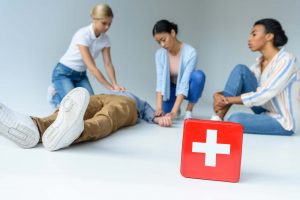How to recognize a stroke and provide first aid

A stroke occurs when a large vessel that carries blood to the brain becomes clogged, depriving the brain cells of the supply of oxygen and nutrients, causing them to die. In this case, the stroke is called ischemic. A ruptured vessel inside the skull also triggers a stroke called hemorrhagic.
Almost 500 thousand people die from stroke every year in Russia. This disease can occur in people of all ages, but is more common in the elderly (people over 60-65 years old).
The main factors that can provoke a stroke:
diseases of the heart and blood vessels;
heredity;
diabetes;
emotional stress;
alcohol consumption, smoking;
insufficient physical activity.
The most common symptoms of a stroke include:
severe headache and dizziness;
numbness of the face and limbs;
violation of coordination and balance;
severe visual impairment (clarity decreases, images may be blurry).
There are 3 simple ways to identify a stroke: Raise – smile – say.
Ask the person to raise their hands. Since the stroke affects the left or right side of the body, one arm will drop.
Examine facial expressions. Ask the patient to smile. The smile will be unnatural, crooked.
Offer to say a simple phrase. With a stroke, it will be difficult to pronounce even your name. Speech will be slurred and illegible.
If at least one of these points is confirmed, call an ambulance immediately!
With a stroke, time is of the essence!
Before the ambulance arrives, provide the victim with first aid:
Place the patient on the bed.
Place a pillow under your head and shoulders. If you are out of the house, a rolled up roller will do.
Unbutton the collar, belt, free the patient from tight clothes.
Calm the person down. Explain to him that everything is fine, the situation is under control, the doctors will soon help.
Provide oxygen access (open a window, window, door).
If the person is nauseous, lay them on their side to prevent vomiting from entering the airways. Place a basin next to it. An elderly person needs to have their dentures removed.
Measure your blood pressure https://en.wikipedia.org/wiki/Blood_pressure. If it is high, give a blood pressure medication that the patient takes constantly.
You can put glycine under the tongue. It improves cerebral circulation. It is allowed to take 10 tablets once.
Prepare the necessary documents for doctors.
A stroke occurs suddenly and does not always have preliminary symptoms. A person’s life at such a moment depends on who is nearby and how quickly the doctors will help.
First aid for stroke is vital. Timely assistance and timely admission of the patient to the hospital can save lives and give chances for successful rehabilitation!


